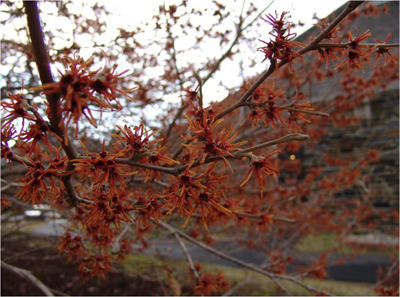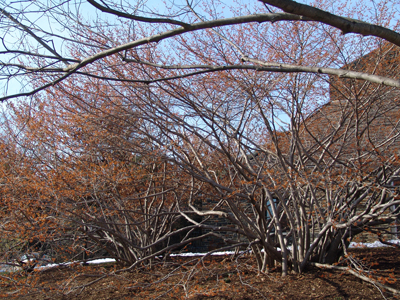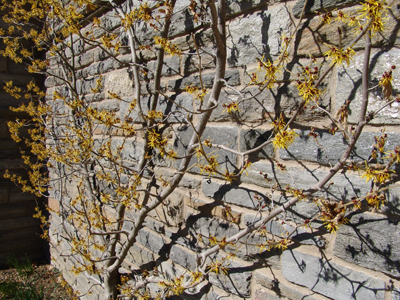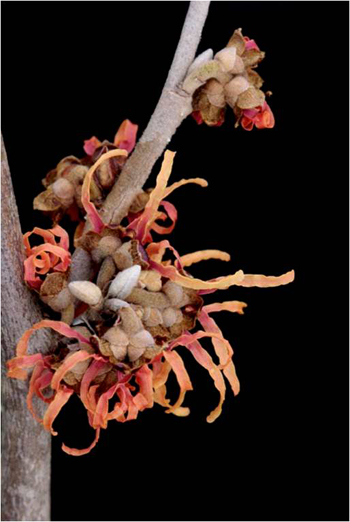‘Strawberries and Cream’, ‘Orange Peel’, and Other Delicious Scents

I’ve been lucky the last couple of days to be out of my office and in the collections preparing for the Witch Hazel Family Seminar tour. Hamamelis is one of my favorite groups of woody plants. As I’ve spent more time studying this genera, I have noticed how varied the blooms and even the fragrance of the different cultivars can be. The following are what I think are the most fragrant witch hazels in our collection.

Fragrant planting of Hamamelis vernalis along Sharples Dining Hall. photo credit: R. Maurer
One of the best scents on campus right now is between Sharples Dining Hall and a stand of Hamamelis vernalis . Also known as the spring witch hazel and reaching a height of nine feet, H. vernalis blooms with small red-to-yellow flowers as early as December. While not known for its floral display, many of H. vernalis cultivars are known for the best fall color among witch hazels including: H. ‘Autumn Embers’ and H. ‘Sandra’.

Hamamelis x intermedia 'Early Bright' espaliered in the Thersea Lang Frangance Garden. photo credit: R. Maurer
A stroll into the Fragrance Garden engulfs you in a fragrance of Hamamelis mollis ‘Early Bright’, a Scott Arboretum introduction. A fantastic, mature specimen is espaliered against the wall of Clothier Hall. A cultivar of the Chinese witch hazel, H. ‘Early Bright’ was selected because its vibrant yellow blooms enliven the landscape two weeks earlier than other H. mollis.

Hamamelis x intermedia 'Early Bright' photo credit: R. Maurer
Hamamelis x intermedia, the hybrid witch hazel, is a cross between H. japonica and H. mollis originally crossed in 1928 at the Arnold Arboretum. Ranging from deciduous shrub to small tree, H. x intermedia hybrid is always among experts favorite witch hazel cultivars. Some of the newer introductions are quite fragrant.
In the lawn near the Cornus florida var. rubra on the north side of Kohlberg Hall you’ll find Hamamelis × intermedia ‘Fire Blaze’. It is still a small specimen but smells great and has pretty apricot-orange blooms. As with most H. x imtermedia cultivars, ‘Fire Blaze’ blooms from February to March with a great vase-shaped habit.

Hamamelis x intermedia 'Strawberries and Cream' photo credit: D. Mattis
Walk down Metesequioa Allée towards Clothier Hall and make a point of getting up close to Hamamelis × intermedia ‘Strawberries and Cream’. I don’t know if it is psychological but to me it really does smell deliciously like strawberries and cream! The flowers are beautiful too with a mixture of soft red and pale yellow – also reminiscent of a strawberry. A rounded shapely shrub, ‘Strawberries and Cream’ blooms from February to March.
Lastly, tucked in the Pinetum is a small specimen of Hamamelis × intermedia ‘Orange Peel’. This is another one that I think may be playing with my senses, but to me, it really does look and smell like little bits of orange zest. An 1988 introduction from Kalmthout Arboretum of Belgium, ‘Orange Peel’ not only has large pale orange flowers, it displays good fall color.
Be sure to come out to the Scott Arboretum today before these unusually beautiful, and very fragrant blooms fade away. P.S. – Catch another great scent currently floating around the Arboretum office and the Winter Garden – Chimonanthus praecox ‘Luteus’.





John Manion
Posted at 14:49h, 12 MarchJuile…nicely written piece – but it sure made me hungry!